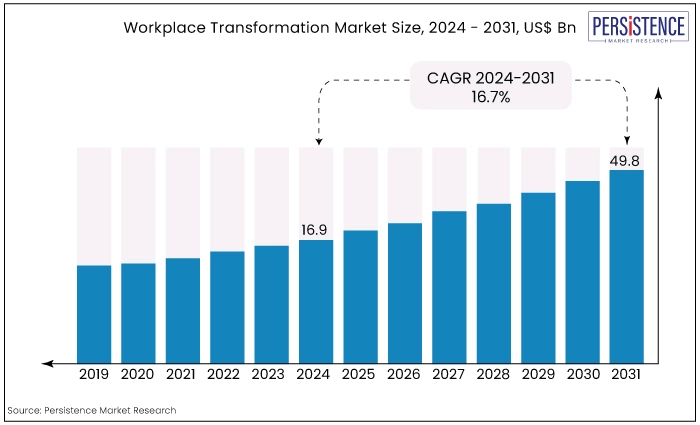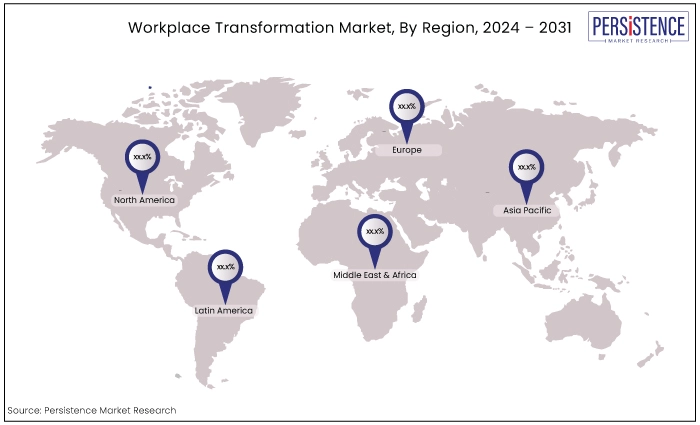ID: PMRREP34669| Upcoming | Format: PDF, Excel, PPT* | IT and Telecommunication

The global market for workplace transformation is expected to increase from US$16.9 Bn in 2024 to US$49.8 Bn by the end of 2031. The market is anticipated to secure a CAGR of 16.7% during the projection period between 2024 and 2031.
Key Highlights of the Market
|
Attributes |
Key Insights |
|
Workplace Transformation Market Size (2024E) |
US$16.9 Bn |
|
Projected Market Value (2031F) |
US$49.8 Bn |
|
Forecast Growth Rate (CAGR 2024 to 2031) |
16.7% |
|
Historical Growth Rate (CAGR 2019 to 2023) |
16.1% |
The workplace transformation market is expected to benefit significantly from the widespread adoption of hybrid work models.
Organizations are increasingly embracing flexibility, allowing employees to work remotely, in the office, or through a combination of both. This shift necessitates investments in technology solutions that support seamless collaboration, communication, and productivity across dispersed team.
Technologies such as cloud computing, collaboration tools, virtual desktop infrastructure (VDI), and unified communications are critical components of enabling effective hybrid work environments.
There is a growing recognition of the importance of employee experience and wellbeing in driving organizational success. Workplace transformation program aims to create a more innovative, collaborative, and flexible work environment that empowers employees and drives business success.
Companies are investing in smart office technologies, IoT-enabled devices, and data analytics to gather insights into employee preferences and behaviors, thereby optimizing workplace environments for better performance and satisfaction.
Organizations are increasingly embracing flexibility in where and how work is conducted, accommodating remote, in-office, and mobile work arrangements. This shift necessitates investments in technologies that support seamless collaboration, such as cloud computing, video conferencing tools, and project management platforms.
Workplace transformation initiatives focus on creating agile and adaptable environments that empower employees to work efficiently regardless of location.
There is a heightened focus on enhancing employee experience and well-being. Employers recognize that a positive work environment directly impacts productivity, satisfaction, and retention.
Workplace transformation strategies include designing ergonomic workspaces, implementing smart office technologies, and promoting wellness programs that support physical and mental health.

The workplace transformation market experienced sustained growth as organizations transitioned from crisis response to long-term strategic planning.
Companies expanded their investments in advanced technologies such as artificial intelligence, IoT, and machine learning to create intelligent workplaces anticipating and responding to employee needs.
The market saw increased collaboration between IT and facilities management teams to drive integrated workplace management systems (IWMS) and optimize space utilization.
This period also witnessed a rise in strategic partnerships between technology providers and industry players to deliver comprehensive workplace solutions that enhance productivity, foster innovation, and support organizational resilience.
The market held a CAGR of 16.1 during the historical period.
The adoption of hybrid work models is expected to remain a prominent trend in the workplace transformation market.
Organizations will continue to embrace flexibility, allowing employees to work from various locations, including remote, in-office, and hybrid arrangements.
The future growth of the market for workplace transformation will be shaped by advancements in digital technologies such as artificial intelligence (AI), machine learning (ML), augmented reality (AR), and the Internet of Things (IoT). The market is projected to secure a CAGR of 16.7& during the forecast period from 2024 to 2031.
Changing Workforce Demographics
Changing workforce demographics significantly drives the workplace transformation market by reshaping organizational priorities, workplace expectations, and technological requirements.
The workforce today comprises multiple generations, each with distinct preferences, values, and expectations regarding work environments.
As young generations become the majority in the workforce, organizations are compelled to adapt their workplace strategies to accommodate these preferences. This includes investing in digital tools, flexible work policies, and collaborative technologies that support remote and hybrid work models.
The skills gap and competition for talent are driving organizations to rethink their workplace strategies to attract and retain top talent.
Workplace transformation initiatives focus on creating attractive work environments that appeal to skilled workers seeking opportunities for career growth, professional development, and meaningful work experiences. This includes investing in learning and development programs, mentorship opportunities, and innovative workspaces that foster creativity and innovation.
Technologies such as virtual reality for training and gamification of learning experiences enhance employee engagement and skills development.
Increasing Trend of Connected Workplaces
The increasing trend of connected workplaces is profoundly driving market growth by reshaping how organizations operate, collaborate, and leverage technology to enhance productivity and efficiency.
Connected workplaces leverage the Internet of Things (IoT) to interconnect devices, sensors, and systems within the office environment.
IoT enables smart building management systems that monitor and control various aspects such as lighting, HVAC (heating, ventilation, and air conditioning), occupancy, and energy usage. These technologies optimize resource management, reduce operational costs, and create energy-efficient work environments.
For example,
The trend towards connected workplaces supports mobility and flexibility in work arrangements. Employees can access corporate networks, applications, and data securely from their laptops, smartphones, or other mobile devices. This mobility enables remote work, hot-desking, and flexible work schedules, accommodating diverse work styles and preferences.
Resistance to Cultural Change
Resistance to cultural change represents another significant restraint in the workplace transformation market. Workplace transformation initiatives often involve adopting new technologies, redefining workflows, and promoting new working methods that may disrupt established organizational cultures and traditions.
Organizational culture plays a crucial role in the success of workplace transformation efforts. Leaders must effectively communicate the benefits of change, address employee concerns, and foster a supportive environment that encourages experimentation and learning.
Resistance to cultural change can hinder the adoption of innovative technologies and impede efforts to create agile, collaborative, and inclusive workplaces.
Cybersecurity Concerns
cybersecurity emerges as a critical restraint as workplaces become increasingly connected and reliant on digital technologies.
The proliferation of IoT devices, cloud computing, and remote work arrangements expands the attack surface for cyber threats such as data breaches, ransomware attacks, and phishing scams.
Organizations must invest in robust cybersecurity measures to protect sensitive data, intellectual property, and employee information from unauthorized access and cyberattacks.
Cybersecurity challenges are exacerbated by the complexity of managing diverse IT environments, including legacy systems, third-party integrations, and decentralized networks.
Ensuring cybersecurity resilience requires ongoing investment in technologies like endpoint security, network monitoring tools, encryption solutions, and employee training programs to mitigate risks and safeguard digital assets.
Integration of Artificial Intelligence
Artificial intelligence (AI) represents a transformative opportunity for the market. AI-powered technologies have the potential to revolutionize how organizations manage their workplaces, enhance employee experiences, and optimize operational efficiencies.
AI algorithms can analyze vast amounts of data generated by I oT sensors, smart devices, and employee interactions to derive actionable insights for workplace optimization.
AI-driven predictive analytics can forecast workspace utilization patterns, helping organizations optimize space allocation, reduce real estate costs, and improve energy efficiency. For instance,
AI-enhanced virtual assistants and chatbots can streamline employee interactions, automate routine tasks, and provide personalized support, enhancing productivity and employee satisfaction.
Also, AI technologies such as natural language processing (NLP) enable advanced workplace communication tools, facilitating seamless collaboration across distributed teams through real-time translation, sentiment analysis, and intelligent content management.
As organizations continue to invest in AI-driven workplace solutions, they can unlock new opportunities for innovation, agility, and competitive advantage in a rapidly evolving business landscape.
Large Enterprise Segment to Dominate the Market
Large enterprises typically have extensive resources and financial capabilities to invest in comprehensive workplace transformation initiatives. They can allocate substantial budgets towards adopting and integrating advanced technologies, such as IoT, artificial intelligence (AI), and cloud computing, which are integral to modernizing their workplaces.
This allows them to implement large-scale projects across multiple locations, ensuring consistency and efficiency in transforming their work environments.
Large enterprises often have complex organizational structures and diverse workforce needs spread across various departments, divisions, and geographical regions.
Workplace transformation in such environments requires addressing a wide range of challenges, including infrastructure modernization, digitalization of workflows, cybersecurity enhancements, and the integration of smart technologies.
Such organizations can afford to implement comprehensive solutions that encompass all aspects of workplace transformation, from physical office design to digital workspace strategies.
North America Takes the Charge
North America, particularly the US, leads in technological advancements and innovation across various sectors, including workplace transformation.
The region is home to many of the world's leading technology companies, which continually innovate and develop cutting-edge solutions for enhancing workplace productivity, efficiency, and employee experience. The region recorded a significant market share.
This region has been at the forefront of adopting digital work trends, including remote work, flexible work arrangements, and virtual collaboration platforms.
The strong economy and business-friendly environment in North America foster innovation and encourage investment in workplace transformation initiatives.
Companies in sectors such as technology, finance, healthcare, and professional services have embraced digital transformation to gain competitive advantage, attract top talent, and drive operational efficiencies.
The region's robust economic growth provides organizations with the financial resources and incentives to invest in upgrading their workplace infrastructure, adopting new technologies, and enhancing employee engagement.

Established market players are acquiring niche technology providers to expand their service offerings and gain a competitive edge. Collaboration between different players is becoming more common, with companies forming partnerships to offer integrated workplace transformation solutions.
The competitive landscape varies regionally based on market maturity, regulatory environments, and cultural factors influencing workplace practices.
While global players dominate with comprehensive offerings and extensive market reach, regional providers and startups also contribute innovative solutions that address localized needs and preferences.
Leading technology companies play a pivotal role in driving innovation and shaping the future of workplace transformation. They offer a wide array of solutions encompassing cloud computing, artificial intelligence (AI), Internet of Things (IoT), cybersecurity, and collaboration tools.
Key Industry Developments
By Enterprise Size
By Service Type
End-Use Industry
By Region
|
Attributes |
Details |
|
Forecast Period |
2024 to 2031 |
|
Historical Data Available for |
2019 to 2023 |
|
Market Analysis |
US$ Billion for Value |
|
Key Regions Covered |
|
|
Key Countries Covered |
|
|
Key Market Segments Covered |
|
|
Key Companies Profiled |
|
|
Report Coverage |
|
|
Customization & Pricing |
Available upon request |
Delivery Timelines
For more information on this report and its delivery timelines please get in touch with our sales team.
About Author